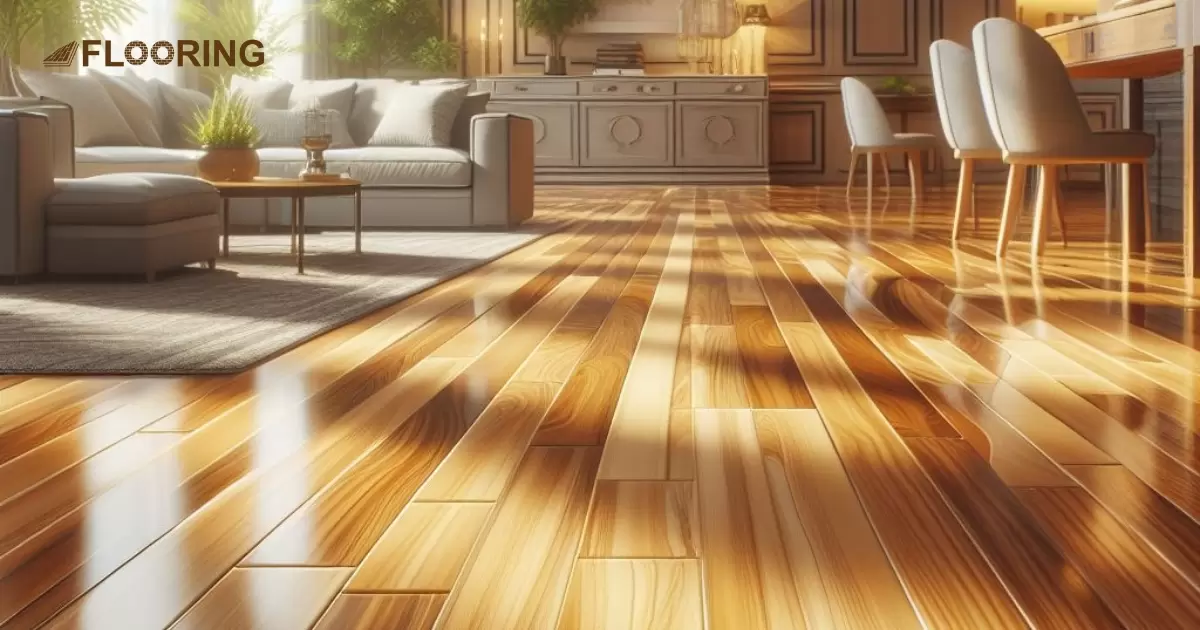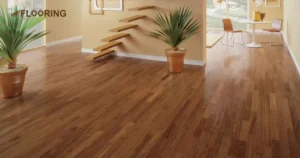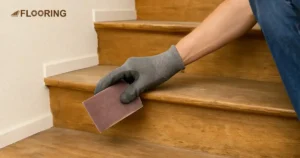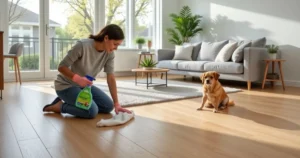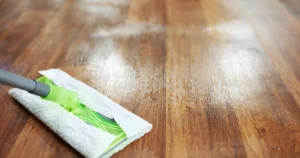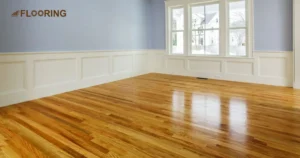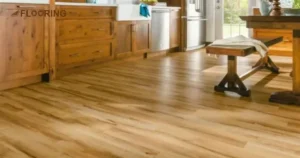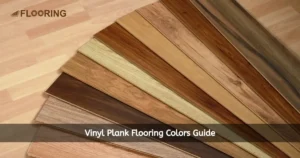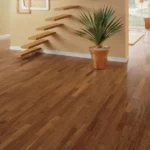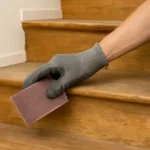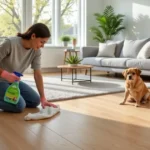Engineered hardwood flooring is made through a combination of hardwood and laminate of high-density layered fibers. The layering technology gives excellent support to these floors in tolerating moisture levels and fluctuations in temperature.
If you are upset about how to clean engineered hardwood floors, don’t worry. If you follow vital steps, you won’t believe how easy it is to clean engineered hardwood floors. A little diligent care can keep hardwood floors as shiny as you.
Engineered floors are also considered future flooring because of their high quality and durability. Engineered hardwood floors are a great alternative to other solid hardwood floors. These floors increase the value of your living as well as your house.
Let’s start learning in detail how to keep your hardwood floors neat and clean.
📑 Table of Content
Key Takeaways
- Sweep and mop regularly. Debris scratches floors. Use a slightly damp mop to lift dirt a broom misses.
- Wipe spills quickly. Liquids can warp planks. Blot spills fast and scrubs gently with mild soap.
- Use rugs in high-traffic zones. Constant footsteps wear down finishes. Rugs protect heavy-use areas.
- Avoid excess moisture. Too much water causes damage. Always thoroughly dry floors after cleaning.
- Refinish cautiously. Engineered wood has limits on sanding. Know guidelines before attempting refinishing projects.
Benefits of Engineered Wood Flooring
This future flooring has multiple benefits, some of which have been mentioned in the table below:
| Benefits | Explanation |
| Budget-friendly | Less expensive than solid hardwood options. More affordable, quality floors. |
| Variety of styles | Available in a range of plank colors and finishes like matte or gloss. Lots of design options. |
| Durable | Top protective layers resist dents, moisture, and wear over decades. Outlasts carpets. Long-lasting investment. |
| Stable material | Alternate wood composite layers prevent swelling and shrinkage over time or changes in humidity and temperature. |
| Easy maintenance | No sanding is required. Sweep and damp mop. |
| Comfort underfoot | Provides a warmth and cushioning feel compared to solid hardwood and tile floors. |
| Eco-friendly choice | Made partially from recycled wood, it is more sustainable. |
| Adds value | Beautiful update that increases a home’s worth. Returns value at resale, too. |
Engineered Wood Floor Cleaning Mistakes
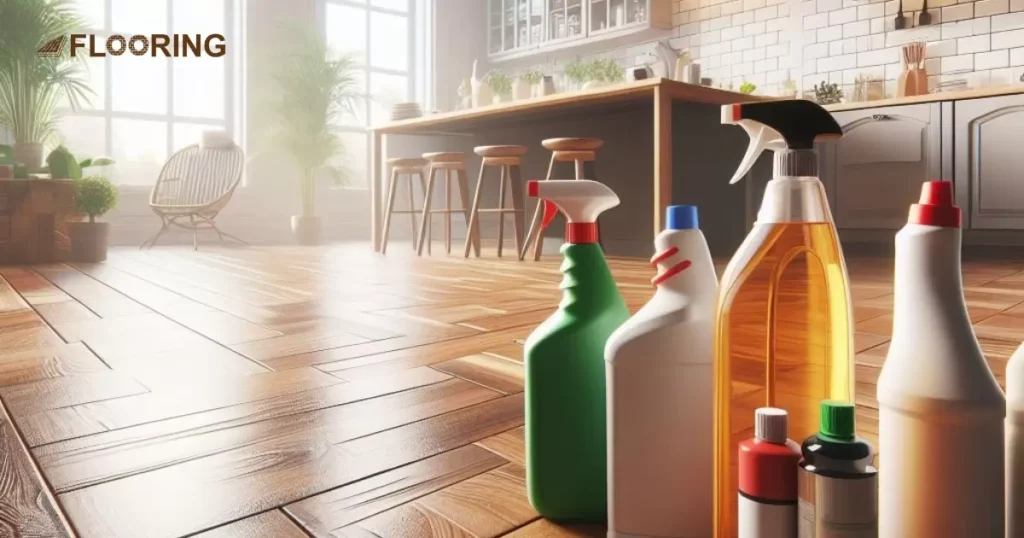
Sometimes, the easiest way to care for your engineered floor is to know what not to do. There are a few cleaning practices to avoid. Let’s explore some common mistakes.
Over-Wetting Warps: Over-wetting warps planks as excess moisture seeps into the seams and core, leading to costly repairs.
Vinegar Degrades: Vinegar, citrus, and soap cleaners degrade the protective shine, causing dull spots and erosion over time.
Detergents Strip: Detergent strips leave surfaces unprotected, so they wear out faster from friction and scratches.
Baking Soda Scuffs: Baking soda scrubs scuff the beautiful surface; gently rub out marks instead of using a damp, soft cloth.
Oil Residue Stains: Oils turn the finish gummy and dark, so immediately wipe up kitchen spills and residues.
Steam Damages: Hot steam from mops can rapidly ruin flooring by making planks cup, shrink, and splinter.
Vacuum Scratches: Grit stuck under a vacuum head results in deep scratches.
Against Grain Wears: Rubbing along the wood grain wears down planks quicker than cleaning along the length of boards.
Supplies for Engineered Hardwood Floor Cleaning
Soft applicators work best; you need simple supplies and materials to clean your engineered hardwood floors. Basic cleaning is simple with items you may already have. You’ll need:
- Lightweight vacuum or soft bristle-broom and dustpan
- Store-bought hardwood floor cleaner diluted with water
- Wool mop / Microfiber mop
- A Bucket
Best Cleaner for Engineered Wood Floors
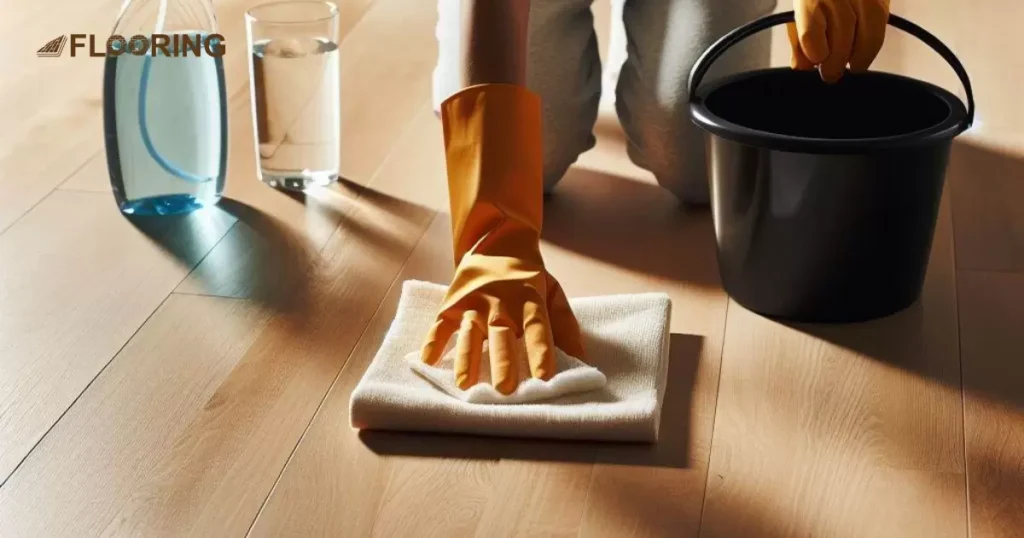
The best practice is to use a floor manufacturer-recommended cleaner because that’ll keep your floor long-lasting. However, choosing between homemade cleaner or store-bought also depends upon you.
If you want to try alternatives or need more information, keep reading because we have all the details for you.
Store Bought Engineered Wood Cleaners
Skip general floor cleaners from the shelf. Find ones declaring “wood floors” on the label instead. Brands specifically for hardwood prevent warps, foggy film, and future damage. Bona Hardwood Floor Cleaner or Simple Green for Wood Floors fit the bill.
You can also seek plant oils in the blend, promising no dulling residue or wax buildup. Cleanwell’s Botanical Floor Cleaner and Polish infuses olive, coconut, and lemon oils to brighten without ammonia or acrylics that ruin finishes over time.
Method’s gel hardwood cleaner is also a good choice if you prefer a greener store-bought brand leaving zero harsh chemical fumes behind.
Natural Homemade Engineered Wood Cleaners
Skip the store and whip up homemade cleaners! Mix warm water, distilled white vinegar, and a few drops of lemon extract in a bucket for a cleaning solution safe for floors. Damp mop with the grain using soft cotton cloth; this lifts dirt without dulling shine from friction.
If you want that extra shiny glow, try another solution. Lukewarm water mixed with lemon juice and olive oil does the trick to leave hardwoods gleaming beautifully. Natural ingredients are money-saving as compared to brand names.
These homemade engineered hardwood cleaners are also better for the environment while gently cleansing floors with safety.
Basic Cleaning of Engineered Hardwood Floors
Dirt is the enemy of engineered wood’s finish. Grab the broom or vacuum with a brush attachment to stop gritty particles from scratching. For low-traffic areas, doing it once or twice a week will work for you.
You must sweep daily if your home is bustling with pets, kids, and parties that increase footsteps over the planks. Then, use a barely moist, damp mop, not dripping wet, to capture what sweeping has left on the floor.
A lightly damp mop removes sticky spills, food crumbs, mud, and leftover grime. The little effort of quick passes with microfiber or soft cloth protects the expensive flooring with minimal time in the long run.
Regular Sweeping
Outdoor grit, crumbs, pet hair, and letting the dirt sit only lead to damage as particles get ground deeper daily under the shoes. Protect that luxury flooring investment against scratches. Regular sweeping debris with a soft nozzle broom or dustpan can save your floor.
If you are vacuuming instead of sweeping, beware of the beater bar. Use a bare floor setting or try attachments like a soft horsehair brush that lifts dirt without scuffing. Keeping grit clean equals keeping floors gorgeous for decades without compromising quality.
Clean with a Damp Mop
Once sweeping is done, stubborn sticky spills, dried mud, and other messes can damage planks with prolonged contact. Keep residues from grinding in further, and protect your floors by mopping debris away on a routine basis before it etches.
A damp but never drippy wet mop is the key to preserving engineered floors during mopping. Excessive moisture seeping into wood leads to swelling, snaking planks or fostering mold. Wring it thoroughly so the mop head is slightly moist before wiping.
After the damp mop, lift away everything that sweeping has missed, and immediately dry the floor to prevent future woes. Allow air drying, and inspect and dry the missed spots before normal traffic traipses again.
Remove Common Stains
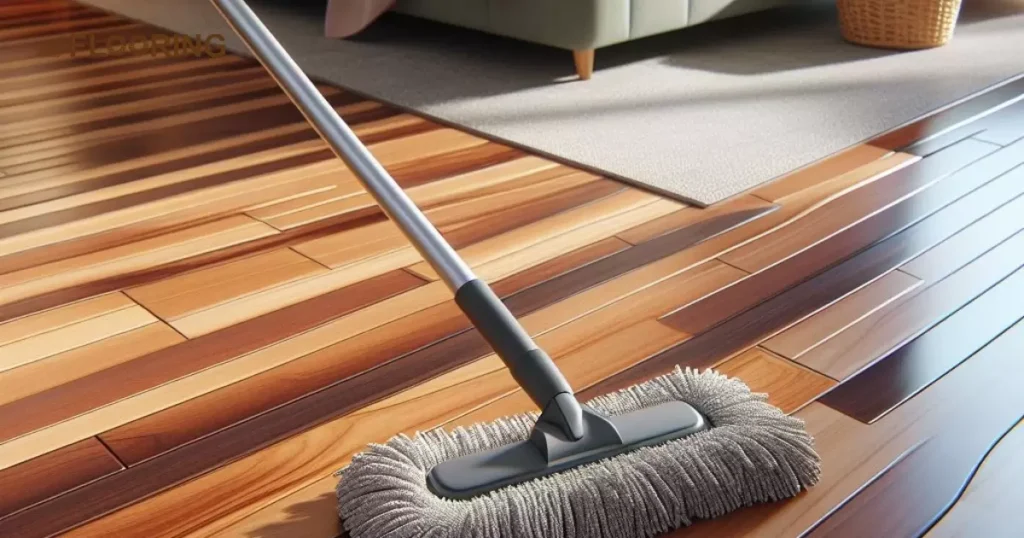
Spills and stains on your beautiful engineered hardwood floors are inevitable. To keep them looking pristine, it’s essential to know how to remove common stains the right way. Try these simple household remedies to lift stains without damaging your floors.
- Immediately blot the area with a clean, dry cloth for food and drink stains like wine, coffee, or juice. Mix a solution of mild dish soap and warm water, dip a soft bristle brush into it, and gently scrub the stain. Rinse the floor with clean water and buff dry with a microfiber mop.
- For tougher oil-based stains like grease, nail polish, or tar, scrape off with a plastic card. Coat the stain with either baking soda or cornstarch, letting it sit for a few hours to draw out the pigment. Vacuum up and repeat if needed.
- Use household items like toothpaste, vinegar, or lemon juice for lasting stains, such as ink or permanent marker. Rub a small amount of any of them over the stain and then wipe away.
Although cleaning methods typically remove stains well, some extra stubborn stains may persist. Refinishing engineered floors is an option, but you can only do this once. If you have refinished them before, consider covering stubborn stains with rugs or furniture instead.
This saves time and money instead of repeatedly refinishing floors when stains inevitably happen. Protecting floors is ideal, but learning to remove or conceal stains properly is a handy backup option.
Use of Vinegar and Water
Vinegar mixed with water makes an ideal regular floor cleaner. It is safe for sealed engineered wood and also gentle on the environment. Mix one cup of white vinegar per every two gallons of lukewarm water. Vinegar’s acidic properties lift away stains without damaging the floor’s finish.
Use a barely damp mop or cloth to wipe the floors. Avoid flooding the planks with too much liquid. Always wipe up excess moisture immediately to prevent warping or water damage. It is essential to take care of engineered wood floors properly when mopping.
Mop following the direction of the floorboards, moving with the wood grain patterns. A vinegar and water blend for light daily cleaning keeps floors pristine without residue buildup. It cleans sealed engineered hardwood floors while being a budget-friendly option.
Protect High-Traffic Areas
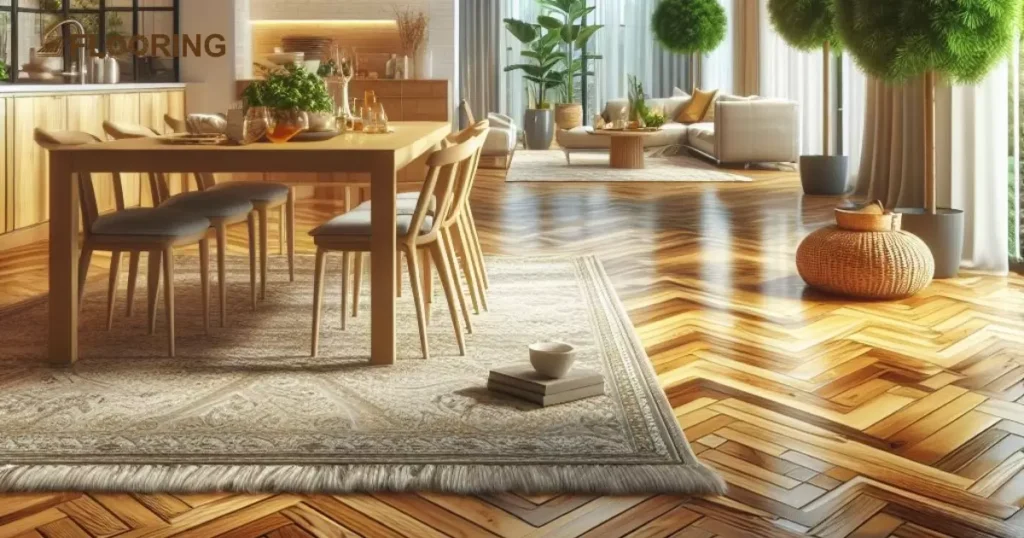
Engineered hardwood can show wear faster in high-traffic zones. Many footsteps in entryways and hallways grind dirt into the finish. Using area rugs or runners protects these vulnerable spots. The rugs take the abuse instead of the floor underneath.
Welcome mats inside and outside exterior doors also stop grit carried-on shoes from directly hitting wood floors. Shake the dirt off your shoes before entering. Sweeping areas like hallways, kitchens, and main paths often have transparent abrasive particles before the ground.
Plush area rugs make kitchens and living spaces cozier while shielding engineered floors. Rotate heavier decorative rugs periodically to distribute minor pressure points evenly. Protect surfaces under furniture legs with felt pads, too.
Though engineered wood wears well, safeguarding heavy-use areas saves unnecessary refinishing. With some simple preventative measures, engineered flooring stays beautiful for years.
Refinish to Fix Major Damage
Good cleaning and using rugs cannot prevent all scratches, as dragging furniture can also damage hardwood floors. When this happens, refinishing may become necessary to make them beautiful again. However, engineered hardwood floors have limits on sanding and refinishing.
Unlike solid hardwood, engineered floors have a thin wood layer on top. Most types can only be refinished once safely. Repeated refinishing leads to uneven spots as the top layer gets thinner. And some modern finishes do not even allow any refinishing at all.
Knowing your specific flooring’s limits on refinishing is crucial before sanding down deep scratches or worn areas. Replacing damaged planks may work better for floors with thinner top wood layers than refinishing the whole floor.
That is why saving extra planks from the original install is wise. Replacing isolated damaged boards retains floor flatness better in the long term. But any refinishing or replacing should be done by flooring professionals.
More Tips and Tricks for Maintaining Engineered Hardwood Flooring
- Use doormats at every entrance to scrape off mud and dirt from shoes before entering. Opt for mats without rubber backing to avoid trapping moisture.
- When entering, remove wet or snow-caked shoes immediately and place them on a tiled surface instead of floors.
- Avoid walking on floors with high heels, as they can damage the floor’s top layer over time.
- Attach felt pads under furniture legs, plant pots, and other items to prevent scuffing floors.
- Clean up spills quickly using recommended cleaners to avoid stains and watermarks.
- Sweep and mop floors regularly using soft bristle brooms and damp mops only.
- Protect high-traffic areas with runners or area rugs to prevent excessive wear.
- Refinish floors professionally if deep scratches or gouges occur to keep floors looking beautiful.
Care for Scratches
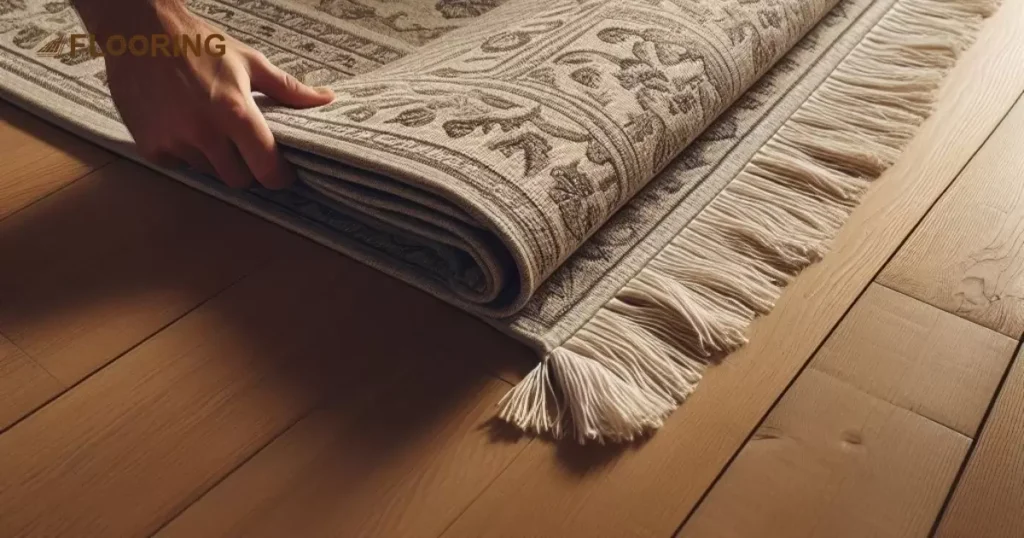
Engineered wood is durable, but scratches can still happen, and if you fix them, your floor will look great. Using a concealer pen or marker in the wood tone hides surface scratches by coloring them to match. This takes seconds and is a budget-friendly option.
You can hire professionals for many minor scratches or a very marred surface. They level out damage by sanding down and applying new stains and protective topcoats. Check manufacturer guidelines on refinishing limits first before attempting this.
Concealing minor scratches as they occur saves time and hassle later versus major refinishing projects down the road.
What Not to Use on Engineered Hardwood Floors
- Avoid excess water that can warp floors – always wipe up spills and wet mopping immediately.
- Do not use harsh chemical cleaners that may damage the finish.
- Steam mops get too hot for engineered wood, potentially warping planks.
- Skip hardwood floor cleaners with abrasives that can scratch.
- Never use steel wool or rough scouring pads that scratch surfaces.
- Sponge mops push dirty water around instead of absorbing it.
- Pure vinegar is too acidic for engineered wood over time.
- Letting water or cleaners sit causes discoloration and possible cupping when boards expand.
Final Words
Caring for engineered wood floors is easy with some basic maintenance. Regular light cleaning paired with prompt spill wipe-ups keeps them looking pristine. Always use recommended cleaners and moisture cautiously to prevent damaging protective finishes.
While these industrial designs are durable against minor scuffs, be gentle overall to make floors last. Lift furniture instead of sliding, attach felt pads under legs, remove shoes with embedded grit, and lay runners in high-traffic paths.
Refinishing hardwood flooring more than once risks uneven sanding. Harsh chemicals and excess moisture warp planks over time. A small investment in care yields huge returns in long-lasting shine and resilience. Give your floors the upkeep they deserve.
Frequently Asked Questions
How do you maintain engineered hardwood floors?
Maintain engineered hardwood floors by sweeping and damp mopping with recommended cleaners, using rugs in high-traffic areas, wiping spills quickly, and handling moisture.
What should you not put on engineered hardwood floors?
Do not put excess water, harsh chemicals, steam mops, steel wool, or rough scouring pads on engineered wood floors since these damage the finish.
How do you make engineered hardwood shine again?
Make engineered hardwood shine again by cleaning thoroughly with a wood floor cleaner and buffing dry, or by having it professionally refinished if it is very worn or scratched.
Why do my engineered hardwood floors look cloudy?
Engineered hardwood can look cloudy from the buildup of dirt, residues, minor scratches, or worn areas in the finish, requiring thorough cleaning or refinishing.
